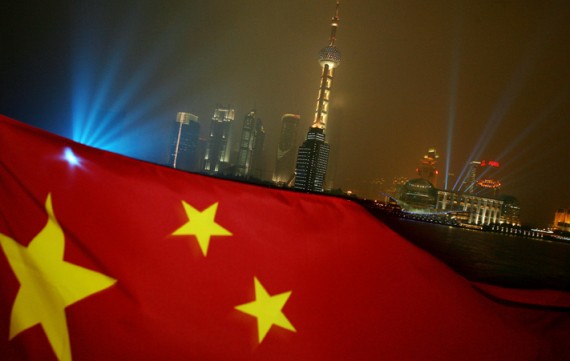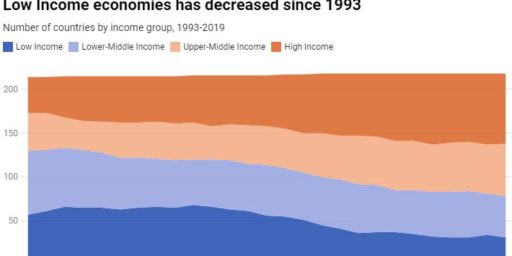GDP Alone Does not Tell the Development Story
Yes, China's GDP growth has been impressive for some time now, but it is not the sole way to understand development.
 Following on from James Joyner’s post on China and the comment thread that ensued, I would note that while China has clearly been engaged in an impressive and sustained growth path, looking just at GDP does not adequately describe China’s state of development at the moment.
Following on from James Joyner’s post on China and the comment thread that ensued, I would note that while China has clearly been engaged in an impressive and sustained growth path, looking just at GDP does not adequately describe China’s state of development at the moment.
The following table included the US and China along with the other NAFTA states, the EU,* and the other two BRIC (Brazil-India-China) countries.
| GDP (PPP) | GDP rank | GDP per capita (PPP) | GDP per capita rank | |
| EU | 14,820,000,000,000 | 1 | $ 32,700 | 42 |
| US | 14,660,000,000,000 | 2 | $ 47,200 | 11 |
| China | 10,090,000,000,000 | 3 | $ 7,600 | 126 |
| India | 4,060,000,000,000 | 5 | $ 3,500 | 163 |
| Brazil | 2,172,000,000,000 | 9 | $ 10,800 | 103 |
| Mexico | 1,567,000,000,000 | 12 | $ 13,900 | 85 |
| Canada | 1,330,000,000,000 | 15 | $ 39,400 | 22 |
Source: CIA World Factbook: GDP and GDP per capita.
These numbers are instructive in a variety of ways. First, if we look at the US’s NAFTA partners we see that Mexico’s economy is larger than Canada’s in absolute terms, but that Canada is clearly more developed when we consider the GDP per capita comparison. And, indeed, this comports with most people’s understanding of the differences in the overall development levels of those two economies.
The BRIC countries are especially interesting, insofar as they show some remarkable size in absolute terms, but their per capita numbers belie a situation of uneven development and a great deal of persons who are economically unproductive (which means, in simple terms, that there are a large number of very poor people in these economies).
Another measure would the United Nation’s Development Programnme’s Human Development Index, which exists on a scale from 1 to 0, which a 1 being perfect development and 0 perfect underdevelopment. The index combines measures of health, education, and living standards, so goes beyond just GDP or GDP per capita comparisons. More information on the index can be found here.
The country with the highest HDI according to the 2010 numbers is Norway, with an HDI of 0.938. The US is 4th with an HDI of 0.902. Indeed, any case from 0.788 up is considered “Very High Human Development.”
China ranks at 89th with an HDI of 0.663. It is flanked by the Dominican Republic (0.669) and El Salvador (0.659). These states all fall in the “Medium Human Development” category.
For comparative purposes the developing economy that most readers are familiar with, Mexico, ranks 56th (0.750) and is towards the upper echelons of “High Human Development.”
Some other states for the sake of discussion:
| HDI | Rank | |
| Brazil | .699 | 73 |
| Egypt | .620 | 101 |
| India | .519 | 119 |
| Zimbabwe | .140 | 169 (of 169 ranked countries) |
The entire list is here [PDF]. Just a list of rankings and other stuff can be found here.
So, yes, China has experiences some remarkable growth in the last several decades, and yes, it has become a significant power in the world. However, the notion that the country has developed to the level of places like Europe or the United States is empirically false. And, further, to truly understand the size of its economy in comparative terms we have to look beyond just the raw GDP numbers.
And, pursuant to James’ post, all this information has to be taken into consideration when evaluating where China is vis-a-vis the US or other cases. Yes, the Beijing airport is nicer than LAX, but then again a huge percentage of the Chinese population live a peasant lifestyle more akin to the 19th Century than the 21st. This has to be taken into consideration as well.
(And yes, this is more complicated than a few numbers. But, then again, this a blog post and not a book. And, the numbers do tell a tale).
—
*Since the rankings in question start with the EU at #1, it seemed easier to include it in the comparison, even if it is not a national economy, rather than to cause confusion over why the US was ranked #2.






I’m always bemused by the lists’ inclusion of the EU as well as its constituent members. There’s some interesting comparative value, to be sure, but the EU isn’t a country and is actually looking increasingly less like one as the economic crisis drags on.
But, yes, I focuses on the arguments in the WSJ piece itself rather than on what is actually the more important reason why China is a developing country and the USA most decidedly is not.
Doesn’t BRIC stand for Brazil, Russia, India and China?
@ponce: Inexplicably, yes. I’ve never understood Russia’s inclusion, as it’s by no means undergoing an economic Renaissance. During boom times for oil and natural gas, it does well; otherwise, it’s in horrible shape.
@James Joyner: I was more aiming the post at some of the comments than to your post.
@ponce: I should have included Russia, but simply failed to do so.
@Steven L. Taylor: Understood. Just acknowledging that the sorry state of life for the average Chinese peasant vis-a-vis even the less well off in America is the real reason that they, not us, are the developing country.
As JJ has noted many times (ad nauseum)(JJ, that is not a complaint about you, it is a complaint to those for whom the obvious has to be explained to, again and again and again…) it is a whole lot easier to grow ones economy when one starts near the bottom than it is to grow it when one starts at the top.
By the way, who has the #1 GDP per capita rank?
@OzarkHillbilly: Qatar.
All of the top 10 are micro-states/city-states and/or petro-states save for Norway.
I wanted to rephrse my question: “What socialist paradise has the best GDP per capita rank?”
Probably Norway at $54,600, #7 in the world.
Thanx Steve and ponce, I am unable to follow the links tonite. (can’t wait for broadband) They say out here it is the iron ore underneath our homes…. I say there ain’t enuf of us out here to make it worth their while.
Norway actually is 13th in oil production and 5th in oil production per capita, which is the reason why they are 7th on the GDP per capita list, if not for that, they would most likely have a GDP per capita like Denmark or Sweden.
@Steven L. Taylor:
And oil exports account for 22% of Norway’s GDP.
@Dave Schuler: You’re right. I was differentiating in my minds states like Qatar, the UAE and such, but Norway is also a major oil producer (and its pop is fairly small as well).
I can only add to Dave’s comment, though Norway exports a lot of oil and NG obviously, the effect of having large reserves makes a big difference in it’s economy beyond exports.
See also The Netherlands and Scotland. But if you want to see the epic failure of a country’s ability to translate mineral wealth to public good Russia is hard to beat these days.
Perhaps, if your vision of paradise is a Starbucks on every corner and 500 channels of reality TV.
Besides no “socialist paradise” is going to top that list since they typically use extra productivity to reduce workload. So GDP per capita does not follow increases in productivity in the same way as in the US.
Still it’s not a question of lower development or prosperity (as assumed by the question), but one of different assumptions on what to do with surplus wealth.
Yes, GDP alone doesn’t tell the story. But then again, “we’re about to lose this one, so let’s move to another measure” is kind of telling as well.
It already is a big story that China in-aggregate has the economic power that it does. I mean, you can remember Chinese-US debt discussions, right?
So no, you may not tour the Chinese countryside and see Canada outside your windows, but for a lot of questions, that’s not what matters.
(James, the BRIC acronym was invented in headier times of Russian investment. IT’s an investment-seller’s shorthand.)
@john personna:
I am not entirely sure of your point.
Bottom line: if the goal is assessing the overall development of China, raw GDP doesn’t work. Ask anyone who studies development. This is not about winning an argument, it is about understanding a situation.
Does that mean that China is El Salvador? Clearly not. Is China very important? Yes. But assessing their overall level of development requires understanding more than the aggregate value of the economy.
I’m saying that for many geopolitical or geoeconomic questions, GDP is the best measure.
Example: who sets the world price for energy?
a) the country with the highest purchases in total?
b) the country with the highest purchases per capita?
… and how is that related to GDP?
@john personna: But I wasn’t writing about setting the price for energy, I was writing about general levels of development.
Don’t you think many of your readers were thinking “national economic power” as they started your article?
(Update: that was the theme in the Joyner piece you leveraged off of.)
@john personna: The title and the first sentence specifically on the issue of development. I am not sure what else I can do, save engage in a paragraph or 12 on what “development” means.
Well, just bear in mind that for many people the question of Chinese growth is not an abstract “China in isolation” thing, and that for many it is about the Chinese-American relationship.
And I think I have seen “per capita” thrown into the latter. “Don’t worry about China” some might say “because they are so far behind, per capita.”
But … Those energy prices matter. Global CO2 emissions matter. The foreign demand for US Treasuries matter.
… and those things are not so tied to “per capita.”
(It’s interesting, and a “new thing” that a nation with a billion poor can also be an economic power, isn’t it?)
More on that last point:
Fourth place in billionaires! We would not have guessed that based on per-capita data, would we?
@john personna: Yes, it is shocking that one data point does not explain everything.
Snark aside, China is going to eventually have to deal with the bimodality in its development. Perhaps it can indefinitely have a billion abjectly poor citizens, but perhaps not. This is no small issue.
I love it when you do snark, because then I can be patient and reasonable.
As above.
@john personna: It is. And nobody is denying that China is a major global player. It’s arguably 3rd, behind the EU and US. The question that started the debate, though, was whether they were the developed country and we developing. And the answer is that, by any measure, China remains a developing country and we’re developed.
James, wasn’t the title of the WSJ piece “China vs. America: Which Is the Developing Country?”
If you are really concerned with “China vs. America” then you are going to look at national measures, including things like that surprising billionaire count.
(Basically, we want to recognize at least “two Chinas.” We have the increasingly prosperous, educated, and globalized trade cities. We also still have the traditional peasantry in the countryside. Averaging across those, with per-capita measures, certainly changes the statistical view … but I think it hides the velocity of change in development hot-spots.)
I have seen international aid organizations visit parts of America like Appalachia to deliver health care to some Americans for the first time in their lives.
If you’re arguing China has pockets of tremendous wealth surrounded general poverty, well, so does America.
@ponce: Not in comparable proportions. Not by a longshot.
90% of Chinese households now have TV sets. 60% now have cell phones.
I can’t drive around my little bubble of massive prosperity without encountering beggars waving a sign at me on nearly every corner.
At least China is run by a political party that acknowledges its countries poverty and spends billions and billions of dollars to alleviate it.
The Republicans, otoh…well, we see their indifference to the suffering around them on display in this very thread.
@john personna: There are 1.3 billion Chinese. A handful of them are exceedingly well off. I’m not sure how that makes them a developed country.
I agree with ponce that we should be just like the Chinese and spend perhaps $10 dollars per person every year to alleviate poverty. Oh, wait, that’s not what you meant?
What I mean is best described by China’s current 5 year plan, which began in March:
Economic targets
— GDP to grow by 7 percent annually on average;
— More than 45 million jobs to be created in urban areas;
— Urban registered unemployment to be kept no higher than 5 percent;
— Prices to be kept generally stable.
Economic restructuring
— Rise in domestic consumption;
— Breakthrough in emerging strategic industries;
— Service sector value-added output to account for 47 percent of GDP, up 4 percentage points;
— Urbanization rate to reach 51.5 percent, up 4 percentage points.
Innovation
— Expenditure on research and development to account for 2.2 percent GDP;
— Every 10,000 people to have 3.3 patents.
Environment & clean energy
— Non-fossil fuel to account for 11.4 percent of primary energy consumption;
— Water consumption per unit of value-added industrial output to be cut by 30 percent;
— Energy consumption per unit of GDP to be cut by 16 percent;
— Carbon dioxide emission per unit of GDP to be cut by 17 percent;
— Forest coverage rate to rise to 21.66 percent and forest stock to increase by 600 million cubic meters;
Agriculture
— Annual grain production capacity to be no less than 540 million tones;
— Farmland reserves to be no less than 1.818 billion mu.
Livelihood
— Population to be no larger than 1.39 billion;
— Life span per person to increase by one year;
— Pension schemes to cover all rural residents and 357 million urban residents;
— Construction and Renovation of 36 million apartments for low-income families;
— Minimum wage standard to increase by no less than 13 percent on average each year;
Social management
— Improved public service for both urban and rural residents;
— Improved democracy and legal system;
— Better social management system for greater social harmony;
— More than 10 percent of all residents will be registered as community volunteers.
Reform
— Encourage qualified enterprises to get listed in stock markets;
— In-depth reform in monopoly industries for easier market entry and more competition;
— Improved government efficiency and credibility:
Imagine what kind of 5 year plan the soulless freaks running the Republican Party would come up with.